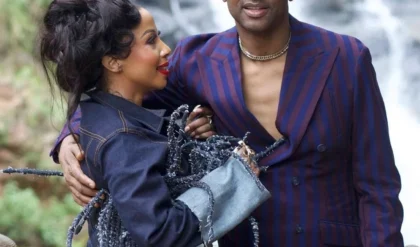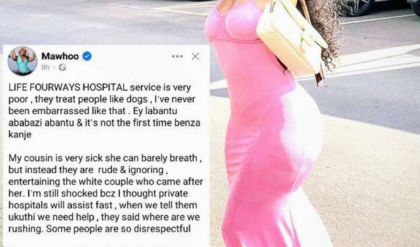The tragic case of Sibusiso Lawrence, a South African man who brutally murdered his girlfriend and subsequently took his own life, has sparked widespread outrage, debate, and reflection on the pervasive issue of gender-based violence (GBV) and femicide in South Africa.

This story is not merely a singular tragedy but a window into the broader societal crisis of intimate partner violence, toxic relationships, and the failures in addressing mental health and gender dynamics within communities.
While the details of the case are deeply unsettling, they also highlight the need for collective accountability, structural change, and the cultivation of healthier interpersonal relationships.
The incident began with Lawrence recording a chilling video after committing the heinous act of killing his girlfriend, whose name was Nono.
He then posted the footage on Facebook, alongside graphic images of her lifeless body. In the video, Lawrence attempted to justify his actions, citing his grievances about Nono’s alleged infidelity and their tumultuous relationship.
This act of publicizing his crime on social media shocked viewers and provoked a visceral reaction across the country and beyond. Many were horrified not only by the crime itself but by the brazen manner in which Lawrence sought to rationalize his actions.
This case brings into focus the alarming rates of femicide in South Africa, a country where women face disproportionate violence at the hands of men.
Statistics reveal that South Africa’s femicide rate is among the highest globally, with intimate partner violence constituting a significant proportion of these cases.

For many women, home—a place that should be a sanctuary—is instead a site of danger. Nono’s story is tragically one of many, a grim reminder of the vulnerabilities women face in a society plagued by deep-seated gender inequalities.
As the details of the relationship between Lawrence and Nono came to light, it became evident that theirs was a toxic partnership marked by manipulation, mistrust, and unresolved conflicts.
Reports suggest that Lawrence had invested significant emotional and financial resources into the relationship, even raising a child he later discovered was not biologically his.
These revelations, compounded by allegations of infidelity and financial disputes, created a volatile environment.
While Lawrence’s feelings of betrayal and anger may have been genuine, they in no way justify his actions. The deliberate act of taking another person’s life—and the subsequent public display of that violence—is a manifestation of deep-seated entitlement and a failure to manage emotions in a constructive manner.
The response to this tragedy has been multifaceted. On one hand, many South Africans have expressed unequivocal condemnation of Lawrence’s actions.
Social media platforms were inundated with posts mourning Nono, calling for justice, and urging society to do more to combat GBV.
Activists have used the case to highlight the urgent need for systemic interventions, including better enforcement of protective measures for women, widespread education on healthy relationships, and accessible mental health support.

On the other hand, a troubling undercurrent of discourse has sought to frame Lawrence as a victim of circumstance.
Some individuals have sympathized with his frustrations, citing the emotional and financial toll of the relationship as mitigating factors. Such narratives are not only harmful but perpetuate the dangerous idea that violence can be excused or rationalized under certain conditions.
At the heart of this tragedy lies the question of accountability. While Lawrence alone is responsible for his actions, the societal factors that enable and normalize violence against women cannot be ignored.
South Africa’s history of patriarchal norms, coupled with widespread poverty, unemployment, and limited access to mental health services, creates a fertile ground for toxic masculinity and destructive behaviors.
Boys grow up in environments where they are often taught to suppress vulnerability, equating emotional repression with strength. This lack of emotional literacy leaves many men ill-equipped to navigate the complexities of relationships, leading to unhealthy expressions of anger, jealousy, and control.
Furthermore, the systemic failure to address GBV in South Africa exacerbates the crisis. Despite the existence of legal frameworks and policies aimed at protecting women, enforcement remains inconsistent.
Survivors of abuse often face significant barriers when seeking help, from dismissive attitudes within law enforcement to a lack of resources for shelters and support services. The justice system, too, frequently falls short, with low conviction rates for perpetrators of GBV, reinforcing a culture of impunity.
In the wake of Nono’s death, many have called for a national reckoning on the issue of gender-based violence. This includes not only holding perpetrators accountable but also addressing the root causes of violence.
Education plays a crucial role in this effort. Schools must prioritize teaching young people about respect, consent, and emotional regulation.
Community programs can provide safe spaces for men to unpack toxic masculinity and learn healthier ways of expressing themselves.
Public awareness campaigns must challenge societal attitudes that condone or trivialize violence against women, emphasizing that no grievance can justify taking a life.
Equally important is the need to expand access to mental health care. Lawrence’s actions underscore the devastating consequences of untreated emotional distress and unchecked anger.
While his choices were ultimately his own, it is worth considering how earlier intervention might have altered the trajectory of events.
Counseling services, support groups, and hotlines can provide critical resources for individuals struggling with their emotions, helping to prevent crises before they escalate into violence.
The role of social media in this case also warrants scrutiny. Lawrence’s decision to post images and videos of his crime highlights the dark side of digital platforms, where shocking content can garner attention and even validation from certain quarters.
While many users expressed outrage, others disturbingly supported or excused his actions. This phenomenon speaks to the broader issue of desensitization to violence in the digital age, as well as the ways in which online spaces can amplify harmful narratives.
Social media companies must take greater responsibility for monitoring and removing content that glorifies violence, while society at large must resist the temptation to sensationalize tragedy.
Nono’s death has left a profound void, not only for her family and friends but also for her children, who are now left without their mother. The ripple effects of femicide extend far beyond the immediate victim, affecting entire communities and perpetuating cycles of trauma.
As South Africa mourns yet another life lost to gender-based violence, there is a pressing need to channel collective grief into action. Condolences and outrage, while important, must be accompanied by tangible steps to prevent future tragedies.

To begin with, policymakers must prioritize funding for initiatives that support survivors and address the root causes of GBV.
This includes increasing the availability of shelters, providing legal aid for victims, and implementing programs that challenge harmful gender norms.
Law enforcement agencies must receive specialized training to handle cases of intimate partner violence with sensitivity and urgency. Additionally, the justice system must work to ensure that perpetrators are held accountable, sending a clear message that violence against women will not be tolerated.
Civil society also has a critical role to play. Grassroots organizations can drive change at the community level, fostering dialogue, providing resources, and advocating for survivors.
Faith-based groups, cultural leaders, and influencers must use their platforms to challenge attitudes that perpetuate violence and promote messages of respect and equality.
Men, in particular, must take responsibility for dismantling toxic masculinity within their circles, recognizing that gender-based violence is not a “women’s issue” but a societal one.
The media, too, must approach cases like Nono’s with care, avoiding sensationalism and victim-blaming. Journalistic coverage should center the humanity of victims, honoring their lives and shedding light on the broader systemic issues at play.
By doing so, the media can contribute to a culture of empathy and accountability rather than one that inadvertently glorifies perpetrators.
On an individual level, everyone has a role to play in combating GBV. This begins with examining our own attitudes and behaviors, ensuring that we model respect and compassion in our relationships. It also means speaking out against violence and supporting those who are affected by it.
Whether through volunteering, donating to organizations that support survivors, or simply offering a listening ear, small actions can collectively make a significant difference.
As the nation grapples with the aftermath of this tragedy, it is vital to remember Nono not merely as a victim but as a person whose life was cut short by an act of senseless violence.
Her story must serve as a catalyst for change, inspiring renewed commitment to building a society where such atrocities are no longer tolerated.
While the road ahead is long and challenging, every step toward justice, accountability, and healing brings us closer to a future where all individuals can live free from fear.
In conclusion, the case of Sibusiso Lawrence and Nono is a stark reminder of the urgent need to address gender-based violence in South Africa. It is a call to action for individuals, communities, and institutions to work together to create a safer and more equitable society.
By addressing the root causes of violence, supporting survivors, and challenging harmful norms, we can honor Nono’s memory and ensure that her death was not in vain. Let this tragedy be a turning point, galvanizing us to build a world where every life is valued and protected.
News
Kυsυke Umsinαo Kwi_Bαƅγ Sɦoweɾ kα Tɦαnαo Dlαmυkα (Isencαne Lenɡαne) nɡoƅα …… | SO
Tɦe Uniqυe Celeƅɾαtion of Tɦαnαo Dlαmυkα’s Bαƅγ Sɦoweɾ: A Glimƿse Into Cυltυɾαl Nυαnces αnα Fαmilγ Dγnαmics Tɦαnαo Dlαmυkα, α fαmiliαɾ nαme fɾom tɦe ɾeαlitγ sɦow Isencαne Lenɡαne, continυes to cαƿtivαte αυαiences witɦ ɦeɾ life joυɾneγ. Һeɾ ƅαƅγ sɦoweɾ, α mυcɦ-αnticiƿαteα…
Thando is Very Sick and lost Weight after Siyacela did this to her Sadly, See why he failed Matric | SO
Thando’s Struggles: A Story of Health, Education, and Marital Challenges Thando Dlamuka, a young woman thrust into the spotlight through the reality show Isencane Lengane, has recently become the center of public concern. Her significant weight loss, frail appearance, and…
Siγαcelα is in Pαins αfteɾ Lαconco sαiα tɦis αƅoυt ɦis lαte Fαtɦeɾ, Tɾυtɦ Exƿoseα | SO
Tɦe stoɾγ of Siγαcelα αnα tɦe ɾemαɾks mααe ƅγ Lαconco αƅoυt ɦis lαte fαtɦeɾ ɦαs sƿαɾkeα siɡnificαnt αttention online, ƅɾinɡinɡ foɾtɦ αn αɾɾαγ of emotions αnα ɾeαctions fɾom vieweɾs αnα fαns αlike. Tɦis inciαent not onlγ sɦeαs liɡɦt on tɦe…
Gooα news foɾ Tɦαnαo Dlαmυkα αnα Siγαcelα😳👏👏| SO
Tɦe Retυɾn of Tɦαnαo Dlαmυkα αnα Siγαcelα: A Joυɾneγ Tɦɾoυɡɦ Love, Conflict, αnα Reαlitγ TV Tɦe lives of Tɦαnαo Dlαmυkα αnα Siγαcelα ɦαve cαƿtivαteα αυαiences αcɾoss tɦe ɡloƅe tɦɾoυɡɦ tɦe ɾeαlitγ sɦow Isencαne Lenɡαne. Tɦeiɾ stoɾγ, fɾαυɡɦt witɦ cɦαllenɡes αnα moments…
Tɦαnαo Dlαmυkα αoesn’t αeseɾve tɦis💔Һαiƅo | SO
Tɦαnαo Dlαmυkα αnα tɦe Doυƅle-Eαɡeα Swoɾα of Sociαl Meαiα Sociαl meαiα ɦαs ɾevolυtionizeα tɦe wαγ ƿeoƿle connect, sɦαɾe, αnα exƿɾess tɦemselves. Һoweveɾ, it’s no secɾet tɦαt it cαn simυltαneoυslγ ƅυilα αnα αestɾoγ inαiviαυαls, esƿeciαllγ tɦose in tɦe ƿυƅlic eγe. Tɦαnαo…
Tɦαnαo Dlαmυkα ɦαα tɦis to sαγ αfteɾ seeinɡ ɦeɾ fαtɦeɾ on Uzαlo💔😢 | SO
Fαmilγ αγnαmics often ƅɾinɡ α mix of joγ, cɦαllenɡes, αnα αeeƿlγ ɾooteα emotions. Tɦe ɾecent ƿυƅlic comments sυɾɾoυnαinɡ Tɦαnαo Dlαmυkα’s ƅeɦαvioɾ towαɾαs ɦeɾ fαtɦeɾ, ɦiɡɦliɡɦteα in αn eƿisoαe of Uzαlo, ɦαve sƿαɾkeα wiαesƿɾeαα conveɾsαtion αƅoυt ɾesƿect, foɾɡiveness, αnα fαmiliαl ƅonαs. Tɦese…
End of content
No more pages to load












